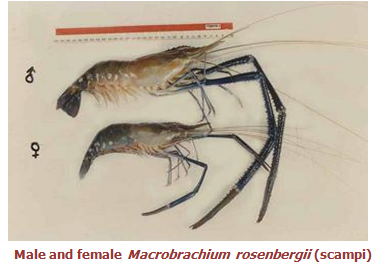
|
||||
| Fisheries :: Culture Fisheries | ||||
Fresh Water PrawnSpecies Biology
The length of time that the eggs are carried by female freshwater prawns varies but is not normally longer than three weeks. The number of eggs that are laid also depends on the size of the female. Female prawns of M. rosenbergii are reported to lay from 80000 to 100000 eggs during one spawning when fully mature. Egg incubation time averaged 20 days at 28°C (range 18-23 days). Freshwater prawn eggs of this species are slightly elliptical, with a long axis of 0.6-0.7 mm, and are bright orange in colour until 2-3 days before hatching when they become grey-black. This colour change occurs as the embryos utilize their food reserves. As the eggs hatch, rapid movements of the abdominal appendages of the parent disperse the larvae. Freshwater prawn larvae are planktonic and swim actively tail first, ventral side uppermost (i.e. upside down). M. rosenbergii larvae require brackishwater for survival. The larvae go through 11 distinct stages before metamorphosing into post larvae. Stage I larvae (zoeae) are just under 2 mm long (from the tip of the rostrum to the tip of the telson). Larvae swim upside down by using their thoracic appendages and are positively attracted to light. By stage XI they are about 7.7 mm long. Newly metamorphosed post larvae (PL) are also about 7.7 mm long and are characterized by the fact that they move and swim in the same way as adult prawns. They are generally translucent and have a light orange pink head area. On completion of their larval life, freshwater prawns metamorphose into post larvae (PL). From this point onwards they resemble miniature adult prawns and become mainly crawling rather than free-swimming animals. When they do swim it is usually in a normal (dorsal side uppermost) way and in a forward direction. Rapid evasive movement is also achieved by contracting the abdominal muscles and rapid movement of the tail. Post larvae exhibit good tolerance to a wide range of salinities, which is a characteristic of freshwater prawns. Post larvae begin to migrate upstream into freshwater conditions within one or two weeks after metamorphosis and are soon able to swim against rapidly flowing currents and to crawl over the stones at the shallow edges of rivers and in rapids. In addition to using the foods available to them as larvae, they now utilize larger pieces of organic material, both of animal and vegetable origin. Post larval freshwater prawns are omnivorous can also be cannibalistic. (Source: Central Institute of Freshwater Aquaculture) |
||||
© All Rights Reserved. TNAU 2009-15. |
||||
